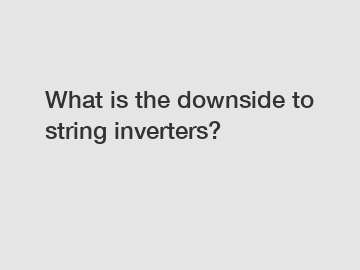Jan. 06, 2024
Energy
What is the downside to string inverters?
String inverters, while widely used in solar power systems, do come with their pitfalls. One major drawback of string inverters is the vulnerability to partial shading or debris accumulation on solar panels. This can significantly reduce the performance and efficiency of the entire system.
Partial shading occurs when some panels in a string are shaded, resulting in a drop in the overall power generation. In a string inverter system, all panels are connected in series, and the system operates at the output of the shaded panel. As a result, the entire string's output decreases to match the lowest producing panel. This phenomenon is known as the 'Christmas light effect.' It leads to an uneven power distribution within the system, causing a loss of energy generation potential.

Debris, such as leaves or branches, can also obstruct sunlight on specific panels, leading to a similar effect as partial shading. Moreover, as the panels age, they might experience reduced performance due to wear and tear or dirt accumulation. These issues affect the overall energy production and might result in the need for regular panel cleaning or maintenance, adding additional costs and labor.
The downside of string inverters can further be understood by comparing them with the alternative – microinverters or power optimizers. While string inverters have been the traditional choice due to their lower initial cost, microinverters offer advantages that address the downsides of string inverters.
Microinverters operate on a per-panel basis, converting the DC power generated by each individual solar panel into AC power independently. This decentralized approach eliminates the 'Christmas light effect' observed in string inverters. Even if one panel is shaded or experiences reduced performance, it does not impact the output of the other panels in the system. As a result, microinverters maximize energy generation by allowing each panel to operate at its highest efficiency.
In addition, microinverters provide real-time monitoring and optimization of each panel's performance. This information enables quick detection of any panel issues, such as reduced output or malfunction, thereby improving maintenance and troubleshooting processes. Furthermore, the independent operation of microinverters reduces the impact of partial shading or debris accumulation, ensuring consistent energy production even in suboptimal conditions.
Despite the advantages of microinverters, the downside to string inverters should be considered based on the specific requirements of the solar power system. The cost factor, scalability, and simplicity of installation are still in favor of string inverters for larger systems. However, as the solar industry continues to evolve, advancements in microinverter technology are narrowing the gap between the two options.
In conclusion, the downside to string inverters lies in their vulnerability to partial shading and debris accumulation, resulting in reduced energy production. This issue can be mitigated by employing microinverters, which offer independent operation per panel and enhanced monitoring capabilities. While string inverters remain a cost-effective choice for large-scale systems, it is essential to evaluate the specific needs and optimize the solar power system accordingly to maximize efficiency and overall energy generation.
The company is the world’s best hybrid storage inverter, Lithium-ion hybrid storage inverter, Wind hybrid storage inverter supplier. We are your one-stop shop for all needs. Our staff are highly-specialized and will help you find the product you need.
Previous: What are the two most important parameters when choosing a specific grid direct inverter?
Next: Which applications benefit most from 12V LiFePO4 Battery technology?
If you are interested in sending in a Guest Blogger Submission,welcome to write for us!
All Comments ( 0 )